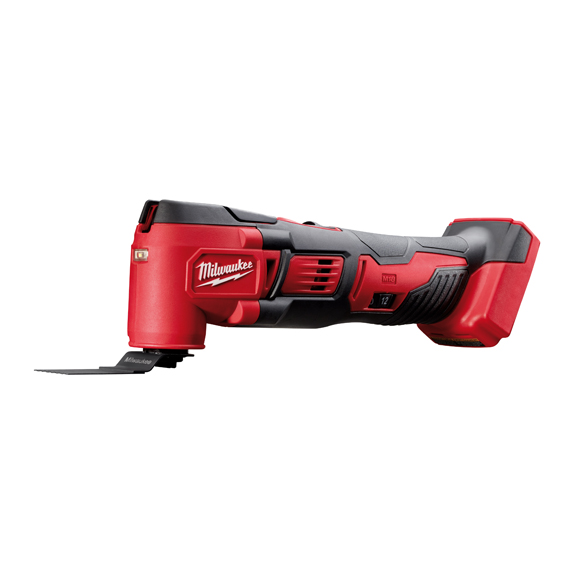
What is a Multi-Tool?
A multi-tool, or oscillating tool, is a home DIYer's best friend. As the name suggests, multi-tools can perform several jobs in one handy power tool.
This means you don't have to purchase various tools for the job, making multi-tools great value for DIYers, and easier to store and maintain.
A multi-tool will have various attachments, and while every model is different, they will generally allow you to sand, saw, scrape, and polish. It is seen as an everyday tool for tradespeople, but they're great for DIYers, too, as it means not having to purchase and store many different tools.
Purchase Multi Tools from Speedy
When using a multi-tool, always remember to wear PPE. They can be loud tools; depending on what you're cutting, there may be debris and dust. A mask, eye protection, and gloves are all essential. You may also want to wear ear defenders and work boots.
What can a multi-tool do?
As mentioned, there are many multi-tool models available. Each one will have different available components, and some will be better at specific tasks than others, so it is important to know what you'll likely need it for and shop accordingly.
However, in general, a multi-tool can perform some of the most popular DIY actions:
- Sawing
Multi tools can often be used with various blades, suitable for sawing various materials, from metal to wood, pipework to plasterboard.
They're brilliant at cutting smaller sections of material, such as skirting boards, doors, or pipework. However, a dedicated saw or jigsaw is needed for larger jobs requiring a long straight line.
- Sanding
Multi tools can also act as sanders. They often come with a small triangular head, ideal for getting into tighter spaces. They're perfect for anyone sanding doors, architrave, or furniture for restoration projects or to create a rough surface on cabinets and bannisters for painting.
However, you'd need a dedicated sander for bigger jobs, such as removing paint or sanding plaster.
- Scraping
Whether scraping paint off a wooden surface (such as a door or windowsill) or scraping out grout from tiles, attachments are available that allow you to scrape away material gently but firmly.
They can also remove cement or even caulk and silicone.
- Polishing
Polishing pads can work with many oscillating tools. This can ensure a smooth surface on stone or other rigid materials, such as stainless steel or tile. Great when restoring old materials or smoothing out a cut.
- Cutting
Similar to sawing, some multi-tool models can allow you to carry out plunge cutting, mortise cutting, or getting into tricky, hard-to-reach areas to chip away at old wood, such as around doorframes.
Attachments can also work to cut carpet, roofing felt, or flooring. You could even use one to carry out crafts such as reupholstery!
Which multi-tool do I need?
You need to think about what you want to do, whether you will need a separate power tool for any particular job, and the conditions of your job.
Do you need to refit skirting boards and then focus on doorframes and doors? You'll need a tool that can both saw wood and sand, so a model that can work with both attachments is ideal.
For polishing concrete slabs or cutting carpets, opt for models which perform highly in these areas.
Separate power tools can offer you a bit of additional power. They are, after all, dedicated to their job. So dedicated sanders, jigsaws, and polishers can often undertake tougher, bigger jobs. It could be worth hiring these for big jobs while using a multi-tool for minor jobs around the house.
It is common for most models to now be cordless, battery-powered multi-tools. This is great for adaptability and handling, as there are no wires and no need for a main power socket.
But again, they will be less powerful than big petrol or mains powered tools, so bear this in mind.
- 2024
- 2023
- December 2023 (13)
- November 2023 (9)
- October 2023 (7)
- September 2023 (10)
- August 2023 (20)
- July 2023 (21)
- June 2023 (17)
- May 2023 (17)
- April 2023 (17)
- March 2023 (14)
- February 2023 (15)
- January 2023 (7)
- 2022
- December 2022 (6)
- November 2022 (12)
- October 2022 (24)
- September 2022 (14)
- August 2022 (12)
- July 2022 (15)
- June 2022 (18)
- May 2022 (14)
- April 2022 (9)
- March 2022 (5)
- February 2022 (5)
- January 2022 (2)
- 2021
- December 2021 (7)
- November 2021 (10)
- October 2021 (1)
- September 2021 (1)
- August 2021 (3)
- July 2021 (3)
- June 2021 (4)
- May 2021 (1)
- April 2021 (1)
- March 2021 (2)
- February 2021 (1)
- January 2021 (1)
- 2020
- 2019
- 2017
- 2016
- 2014
- 2013
- 2012
- 2011


